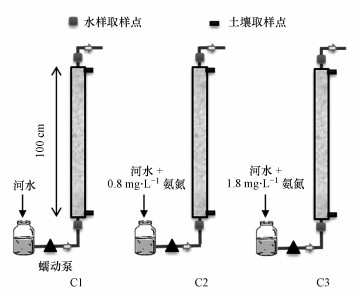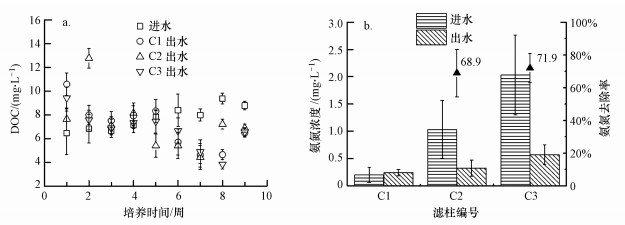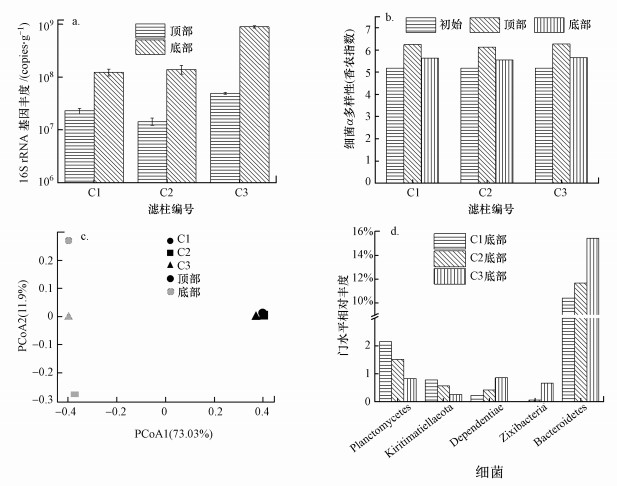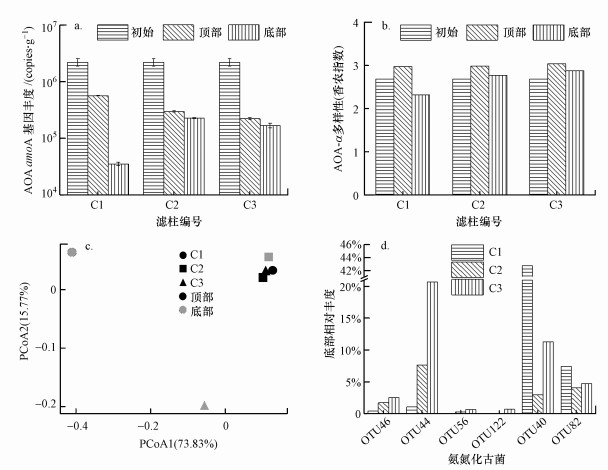 , 王巧娟2, 柏耀辉2, 齐维晓1, 刘会娟1
, 王巧娟2, 柏耀辉2, 齐维晓1, 刘会娟1
 , 曲久辉1,2
, 曲久辉1,21. 清华大学环境学院, 清华大学水质与水生态研究中心, 北京 100084;
2. 中国科学院生态环境研究中心, 饮用水科学与技术重点实验室, 北京 100085
收稿日期: 2020-03-26; 修回日期: 2020-04-17; 录用日期: 2020-04-17
基金项目: 国家自然科学基金项目(No.51820105011)
作者简介: 赵健(1993-), 男, E-mail:j-z20@mails.tsinghua.edu.cn
通讯作者(责任作者): 刘会娟, E-mail:hjliu@tsinghua.edu.cn
摘要:通过小试滤柱模拟河岸过滤,结合荧光定量PCR和高通量测序等手段研究了河岸过滤对氨氮的削减效能和进水氨氮浓度对细菌与氨氧化微生物的影响.结果表明,低浓度(0.2 mg·L-1)氨氮未被削减,较高浓度(1.0 mg·L-1和2.0 mg·L-1)氨氮的削减率可达70%.进水处细菌丰度随氨氮浓度升高而增加,细菌群落组成随氨氮浓度升高发生规律性变化.出水处氨氧化古菌(Ammonia oxidizing archaea,AOA)丰度与氨氮浓度呈负相关,氨氧化细菌(Ammonia oxidizing bacteria,AOB)丰度与氨氮浓度无显著相关关系;进水处AOA-α多样性与氨氮浓度呈正相关,但AOB-α多样性与氨氮浓度呈负相关;进水处AOA群落组成受氨氮浓度影响,而进、出水处AOB群落组成均受氨氮浓度影响.可见,进水氨氮浓度会影响河岸过滤对氨氮的削减效能,还会影响细菌、氨氧化微生物的丰度及群落结构,AOB对氨氮浓度的变化比AOA更敏感.
关键词:河岸过滤氨氮削减细菌氨氧化微生物群落结构
Ammonium nitrogen removal and effects of its concentration on bacteria and ammonia-oxidizing microorganisms during riverbank filtration
ZHAO Jian1
 , WANG Qiaojuan2, BAI Yaohui2, QI Weixiao1, LIU Huijuan1
, WANG Qiaojuan2, BAI Yaohui2, QI Weixiao1, LIU Huijuan1
 , QU Jiuhui1,2
, QU Jiuhui1,21. Center for Water and Ecology, School of Environment, Tsinghua University, Beijing 100084;
2. Key Laboratory of Drinking Water Science and Technology, Research Center for Eco-Environmental Sciences, Chinese Academy of Sciences, Beijing 100085
Received 26 March 2020; received in revised from 17 April 2020; accepted 17 April 2020
Abstract: Ammonium nitrogen removal during riverbank filtration (RBF) and the effects of its concentration on bacteria and ammonia oxidizing microorganisms were explored in laboratory-scale column study using real-time PCR and high-throughput sequencing. Results showed that ammonium nitrogen could not be removed at its concentration of 0.2 mg·L-1, while its removal efficiency could be up to 70% at initial concentration of 1.0 mg·L-1 and 2.0 mg·L-1. Bacterial abundance of inlets of columns increased with ammonium nitrogen concentration. Bacterial community composition of inlets changed regularly with increasing ammonium nitrogen concentration. Ammonia oxidizing archaea (AOA) abundance of outlets were negatively correlated with ammonium concentration, but no significant correlation was found between Ammonia oxidizing bacteria (AOB) abundance and ammonium nitrogen concentration; Ammonium nitrogen concentration was positively correlated with AOA-α diversity of inlets, but negatively correlated with AOB-α diversity of inlets; AOA community composition of inlets were affected by ammonium nitrogen concentration, while AOB community composition of inlets and outlets were both affected by ammonium nitrogen concentration. Overall, ammonium nitrogen concentration affects its removal efficiency during RBF and it also affects abundance and community composition of bacteria and ammonia-oxidizing microorganisms. AOB are more sensitive to the changes in ammonium nitrogen concentration than AOA.
Keywords: riverbank filtrationammonium nitrogen removalbacteriaammonia-oxidizing microorganismscommunity composition
1 引言(Introduction)河岸过滤是一种低耗、高效、依托于自然过程的净水技术(Kuehn et al., 2000;Sudhakaran et al., 2013;Hollender et al., 2018), 地表水通过土壤流向取水井的过程中, 可通过生物降解、吸附等作用有效削减N、微量有机物及重金属等污染物(Sontheimer, 1980;Huntscha et al., 2013;Bertelkamp et al., 2014).欧洲将河岸过滤应用于饮用水预处理已逾150年, 在中国河岸过滤也具有较好的应用基础和前景(Hu et al., 2016).根据《2019年中国水资源公报》, III类水及以下(氨氮浓度≥ 1.0 mg·L-1)河长占评价河长的59.8%, V类水及以下(氨氮浓度≥ 2.0 mg·L-1)河长占评价河长的22.9%, 氨氮仍是当前我国河流的主要污染物.以往的研究发现河岸过滤对不同浓度氨氮的削减率有较大区别, 如荷兰Lek河源水氨氮浓度为0.1 mg·L-1, 河岸过滤未削减氨氮(De Vet et al., 2009;Bertelkamp et al., 2015);我国郑州黄河“九五”滩地河岸过滤氨氮源水浓度为0.81 mg·L-1, 其氨氮削减率为47%;徐州奎河氨氮浓度为17.09 mg·L-1, 河岸过滤对其削减率为99%;成都饮马河氨氮浓度为57.5 mg·L-1, 河岸过滤对其削减率为96%(Hu et al., 2016).
在河岸过滤过程中, 微生物的降解作用对污染物, 特别是氨氮的去除有较大影响(Hu et al., 2016).河岸过滤包含好氧区、低氧区和厌氧区, 其中“河岸过滤第一米”是生化反应最活跃度的区域(Hollender et al., 2018).已有对污水处理厂、河流和土壤的研究表明, 氨氮浓度、细菌、氨氧化微生物丰度及群落结构之间具有相关关系(Verhamme et al., 2011;孙海美等, 2012;刘涛等, 2013).那么, 河岸过滤过程中氨氮浓度是否会影响河岸土壤中细菌及氨氮化微生物群落结构呢?因此, 本研究将通过滤柱模拟河岸过滤过程中污染物衰减最为显著的区域—“河岸过滤第一米”, 研究其对不同浓度氨氮的削减效能, 氨氮浓度选择为河流中常见的浓度范围0.2~2.0 mg·L-1.同时, 结合荧光定量PCR和高通量测序研究氨氮浓度对土壤中微生物(细菌、氨氧化古菌(Ammonia oxidizing archaea, AOA)和氨氧化细菌(Ammonia oxidizing bacteria, AOB))丰度及群落组成的影响, 以期为河岸过滤在我国的应用提供一定的理论和技术支持.
2 材料与方法(Materials and methods)2.1 滤柱实验实验用土取自潮白河(北纬40°06′33″, 东经116°43′45″)岸边带1 m深的好氧不饱和层处, 去除较大的有机颗粒(树根等)后备用.砂土的粒度分布、有机质含量、pH-H2O和阳离子交换量等参数见表 1.潮白河河水作为实验用水, 每周更新一次并测试水质参数(溶解氧(DO)、pH、ORP、NH4+-N、NO3--N和溶解有机碳(DOC)), 结果见表 2.
表 1(Table 1)
| 表 1 沙粒参数分析 Table 1 Analysis of sand parameters | |||||||||||||||||||||||||||
表 1 沙粒参数分析 Table 1 Analysis of sand parameters
| |||||||||||||||||||||||||||
表 2(Table 2)
| 表 2 水质参数分析 Table 2 Analysis of water parameters | ||||||||||||||
表 2 水质参数分析 Table 2 Analysis of water parameters
| ||||||||||||||
在3根黑色PVC管(长度1 m, 直径40 mm, 壁厚2 mm)中填充潮白河岸边带砂土以构建模拟“河岸过滤第一米”的滤柱, 编号分别为C1、C2和C3.填充前取5 g混合均匀的砂土3份, 分别作为C1、C2和C3土壤的初始样品, 储存于-80 ℃, 用于微生物群落分析.图 1为实验装置示意图, C2和C3的进水氨氮浓度与C1不同, 其它设置均与C1一致.进水容器为5 L棕色烧瓶, 使用蠕动泵(中国, 保定市)从柱底部注入恒定水流, 单柱加载流量为0.45 L·d-1, 通过氯化钾示踪剂实验估计柱内停留时间约为42 h.C1进水氨氮浓度为自然(河水)浓度, C2和C3进水氨氮浓度分别为“自然浓度+0.8 mg·L-1”和“自然浓度+1.8 mg·L-1”.滤柱实验在室温(20~25 ℃)下进行, 每周对各柱出水水质参数包括DO、pH、ORP、NH4+-N、NO3--N和DOC等进行检测.连续运行4个月后, 分别从各柱底部和顶部取土壤样品(充分混合土壤后取5 g作为代表性样品), 储存于-80 ℃, 用于微生物群落分析.
图 1(Fig. 1)
 |
| 图 1 实验装置示意图 Fig. 1Schematic of the experimental setup |
2.2 理化指标测定土壤理化指标测定, 粒度分布使用激光粒度分析仪(LS 13320, Beckman Coulter?)测定, 其它参数包括pH-H2O、总有机质含量和阳离子交换量测定方法参考Bertelkamp等(2015)的方法.水质理化指标测定, DO和pH使用多参数水质分析仪(美国, Thermo)测定, DOC通过Shimadzu TOC CPH/CPN分析仪(日本)在680 ℃催化燃烧下测定.NH4+-N浓度使用纳氏试剂分光光度法测定(国家标准HJ 535-2009), NO3-的浓度用配有Dionex IonPac AS11-HC色谱柱的ICS-5000(美国, Thermo)测定.
2.3 细菌、氨氧化古菌(AOA)和氨氧化细菌(AOB)丰度测定土壤DNA提取采用FastDNA?SPIN土壤试剂盒(MP Biomedicals, 美国)对所有样品的DNA进行提取, 采用琼脂糖凝胶电泳(琼脂糖凝胶浓度:1%, 电压:5 V·cm-1时间:20 min)对DNA完整性进行质检.
荧光定量PCR——绝对定量采用染料法(SYBR Green I)进行荧光定量PCR, 所用引物和反应程序参见表 3.扩增体系为20 μL, 包括2 × ChamQ SYBR Color qPCR Master Mix 10 μL, 正反向引物(5 μmol·L-1)各0.4 μL, DNA模板2 μL, ddH2O 7.2 μL.在博日LineGene9600 plus型荧光定量PCR仪中进行反应.
表 3(Table 3)
| 表 3 细菌、AOA和AOB的PCR扩增引物和反应条件 Table 3 The oligonucleotide sequences of the primers and thermal profile of bacteria, AOA and AOB | ||||||||||||||||||||||||
表 3 细菌、AOA和AOB的PCR扩增引物和反应条件 Table 3 The oligonucleotide sequences of the primers and thermal profile of bacteria, AOA and AOB
| ||||||||||||||||||||||||
2.4 细菌、氨氧化古菌(AOA)和氨氧化细菌(AOB)群落结构分析2.4.1 Illumina HiSeq平台高通量测序针对细菌的16S rRNA基因、AOA和AOB的amoA基因, 采用表 3中的引物使用PCR仪ABI GeneAmp? 9700型(美国)进行PCR扩增, 确保PCR产物目的条带大小正确、浓度合适的情况下使用HiSeq测序平台(Illumina, Inc., 美国)进行高通量测序.
2.4.2 细菌、AOA和AOB多样性分析使用Flash(1.2.11)软件对HiSeq测序所得的双端序列数据进行优化.使用Usearch(7.0)以97%相似水平进行operational taxonomic unit(OTU)聚类.用Mothur基于OTU水平计算微生物群落的Shannon(香农)指数, 它常用来估算样本中微生物多样性的指数, 反映群落alpha多样性.Shannon值越大, 说明群落多样性越高.在OTU水平, 通过基于Bray-Curtis距离的PCoA分析研究不用样品间的微生物群落组成的差异性.基于样本中群落相对丰度数据, 在门水平运用费舍尔精确检验来检验两样本间存在显著差异的细菌, 其中CI计算方法为AsymptoticCC, 多重检验校正为fdr, 置信区间为95%.
3 结果与讨论(Results and discussion)3.1 河岸过滤对氨氮的削减滤柱运行期间, C1、C2和C3进水氨氮浓度分别为“自然浓度”、“自然浓度+0.8 mg·L-1”和“自然浓度+1.8 mg·L-1”.实验包括微生物培养和氨氮削减性能评估两个阶段, 各柱稳定消耗溶解性有机碳(DOC)标志着培养期的结束与氨氮削减性能评估实验的开始.图 2a为3个滤柱C1、C2和C3在培养期(前9周)进、出水的DOC浓度变化, 前5周出水DOC值比进水高, 6~9周, 各柱出水DOC较进水降低且趋于稳定, 说明柱内微生物功能已到达相对稳定的状态(Bertelkamp et al., 2014).9~17周进水的DO值为(5.35±0.19) mg·L-1, C1、C2和C3出水的DO分别为(4.09±0.51)、(4.14±0.82)和(4.16±0.55) mg·L-1, 表明各滤柱进、出水处均处于好氧状态.而各滤柱出水DO比进水DO均降低1.20 mg·L-1左右, 说明氨氮削减性能评估实验期间各柱DO消耗差异较小且相对稳定.
图 2(Fig. 2)
 |
| 图 2 前9周进、出水DOC浓度(a)和9~17周各柱氨氮去除效能(b) Fig. 2DOC concentrations of influents and effluents of columns during first 9 weeks (a) and ammonium nitrogen removal of each column during 9~17 weeks (b) |
图 2b为9~17周各柱进、出水氨氮浓度的测定结果及氨氮去除率.C1中氨氮基本未被去除(进水氨氮浓度为(0.20±0.14) mg·L-1, 出水为(0.24±0.06) mg·L-1), 该结果与荷兰Oasen水厂河岸过滤的研究结果一致(De Vet et al., 2009).C1进水氨氮浓度较低, 而荷兰Oasen水厂河岸过滤源水——Lek河氨氮浓度((0.08±0.03) mg·L-1)也常年处于较低水平(Bertelkamp et al., 2015).C2和C3进水氨氮浓度分别为(1.03±0.53) mg·L-1和(2.03±0.73) mg·L-1, C2和C3对氨氮削减率较高(图 2b), 分别为68.9%和71.9%.因此, 河岸过滤的氨氮削减效能可能与进水氨氮浓度有关.魏佳明等在表流湿地的研究中发现低浓度氨氮(0.2 mg·L-1)去除率仅为1.6%(魏佳明等, 2016), 其原因是氨化作用快于氨氧化作用(Ligi et al., 2014;王秉政, 2015).王秉政等研究发现环境温度为25 ℃, 进水氨氮浓度为1.0 mg·L-1和2.0 mg·L-1时, 生物降解是砂土渗滤过程中氨氮去除的主要途径(王秉政, 2015).本研究中不同浓度氨氮在河岸过滤中削减性能差异也可能与生物作用有关, 因此, 进一步研究了不同进水氨氮浓度下微生物群落结构的特征.
3.2 氨氮浓度对细菌群落结构的影响3.2.1 细菌丰度与α多样性图 3a为连续运行4个月后各柱进水处(底部)和出水处(顶部)土壤16S rRNA基因的定量结果.C1、C2和C3底部分别为1.23×108、1.39×108和8.96×108 copies·g-1, 顶部分别为2.30×107、1.44×107和4.91×107 copies·g-1.各柱底部细菌丰度显著高于顶部, 说明出水处细菌丰度比进水处低.细菌丰度为“C1底部 < C2底部 < C3底部”, 而C1、C2和C3底部氨氮浓度分别为(0.20±0.14)、(1.03±0.53)和(2.03±0.73) mg·L-1.因此, 底部细菌丰度可能随进水氨氮浓度的增加而增加.
图 3(Fig. 3)
 |
| 图 3 初始样品、4个月时各柱底部和顶部16S rRNA基因丰度(a);初始、4个月时各柱底部和顶部α多样性香农指数(b);4个月时各柱顶部和底部的PCoA图(c);底部相对丰度与氨氮浓度呈正(负)相关的门水平细菌(d) Fig. 316S rRNA gene abundance of origin, bottom and top of each column (4 months) (a); alpha diversity Shannon index of origin, bottom and top of each column (4 months) (b); PCoA plots at the top and bottom of each column (4 months) (c); relative abundance of microbes (at the phylum level) at bottom of columns positively or negatively correlated with ammonium nitrogen concentration (d) |
通过细菌α多样性(香农指数)分析发现(图 3b), 相对于初始土壤样品, 连续运行4个月后各柱顶部和底部α多样性均增加, 说明使用河岸过滤可能会增加α多样性, 而滤料截留微生物(郭明昆等, 2016)可能是α多样性增加的主要原因.各柱顶部、底部细菌α多样性比较接近, 说明细菌α多样性不受氨氮浓度影响, 赵维等研究发现氨氮浓度与细菌α多样性无显著相关性(赵维等, 2019).
3.2.2 细菌群落组成(β多样性)图 3c所示为连续运行4个月后各柱顶部和底部样品的PCoA图, 顶部距离较近, 说明各柱顶部细菌群落组成相似度较高;底部样品距离较远, 表明各柱底部细菌群落组成差异性较大.氨氮浓度会影响细菌群落组成(Leff et al., 2015;Zeng et al., 2016;Nie et al., 2018), 本研究中氨氮浓度对滤柱底部细菌群落组成影响较大.
使用费舍尔精确检验(Corrected p value < 0.05)分别对C1底部和C2底部, C2底部和C3底部门水平的细菌进行了统计学显著性差异检验.图 3d显示了门水平显著变化的细菌, 有2种(Planctomycetes和Kiritimatiellaeota)随着氨氮浓度的升高相对丰度降低, 3种(Dependentiae, Zixibacteria和Bacteroidetes)随着氨氮浓度的升高相对丰度升高.其中, 河岸过滤现场的研究中发现Bacteroidetes相对丰度与氨氮浓度呈正相关(Meng et al., 2020).
底部细菌丰度与群落结构均受氨氮浓度影响, 与以往研究结果一致(Nie et al., 2018;赵维等, 2019).但顶部细菌丰度及群落结构均未被影响, 原因可能是顶部氨氮浓度差异较小(氨氮浓度, C1顶部:(0.24±0.06) mg·L-1;C2顶部:(0.32±0.15) mg·L-1;C3顶部:(0.57±0.18) mg·L-1).氨氮浓度于0.2~2.0 mg·L-1范围的变化对进水处细菌的丰度及群落组成影响显著, 对出水处细菌影响较小.
3.3 氨氮浓度对氨氧化微生物群落结构的影响3.3.1 对氨氧化古菌(AOA)的影响图 4a为初始样品、连续运行4个月后进水处(底部)和出水处(顶部)样品的AOA amoA基因拷贝数, 相对于初始样品, 各柱顶部和底部的基因拷贝数均显著降低, 可能是因为体系介质发生了变化(由砂土到水土混合).顶部AOA丰度表现为“C1顶部> C2顶部> C3顶部”, 氨氮浓度(C1顶部:(0.24±0.06) mg·L-1;C2顶部:(0.32±0.15) mg·L-1;C3顶部:(0.57±0.18) mg·L-1), 顶部AOA丰度可能随进水氨氮浓度的升高而降低.底部氨氮浓度差异较大(C1、C2和C3底部氨氮浓度分别为(0.20±0.14)、(1.03±0.53)和(2.03±0.73) mg·L-1, 但AOA丰度无规律性变化.因此, 氨氮浓度的升高不是顶部AOA丰度降低的原因.文献研究表明硝氮浓度与AOA丰度呈负相关(Zhang et al., 2008;李露等, 2015), 因而C2和C3顶部硝氮浓度的升高可能是AOA丰度下降的原因.
图 4(Fig. 4)
 |
| 图 4 初始样品、4个月时各柱底部和顶部AOA amoA基因丰度(a)、α多样性香农指数(b);4个月时各柱顶部和底部的PCoA图(c);底部相对丰度与氨氮浓度呈正(负)相关的OTUs(d) Fig. 4AOA amoA gene abundance (a) and alpha diversity Shannon index (b) of origin samples, bottom and top of each column at 4 months; PCoA plots at the top and bottom of each column at 4 months (c); AOA relative abundance of bottom of columns positively or negatively correlated with ammonium nitrogen concentration (d) |
图 4b中显示了初始样品、连续运行4个月后进水处(底部)和出水处(顶部)样品的AOA-α多样性香农指数的结果.底部AOA的α多样性分布为“C1底部 < C2底部 < C3底部”, 而C1、C2和C3底部氨氮浓度分别为(0.20±0.14)、(1.03±0.53)和(2.03±0.73) mg·L-1即“氨氮浓度:C1底部 < C2底部 < C3底部”.因此, 底部AOA-α多样性可能与氨氮浓度呈正相关, 先前的研究曾报道过AOA-α多样性与氨氮浓度的正相关关系(He et al., 2007;Bollmann et al., 2014;李露等, 2015).
图 4c通过基于Bray-curtis距离矩阵的PCoA分析探讨了连续运行4个月后底部和顶部AOA群落组成(OTU水平)的差异性.各柱顶部样品距离较近, 底部样品距离较远, 说明各柱顶部AOA群落组成相似度较高, 底部差异性较大.氨氮浓度主要影响底部AOA群落组成, AOA群落组成受氨氮浓度影响与之前研究的结果一致(Erguder et al., 2009).对各底部样品质控后, 通过97%的OTU聚类共获得73个AOA的OTUs.费舍尔精确检验(Corrected p value < 0.05)用于检验两样品之间(C1底部和C2底部, C2底部和C3底部)存在显著性差异的OTUs.图 4d中显示了各柱底部存在显著性差异的OTUs, 其中OTU46 (s_uncultured_ammonia-oxidizing_crenarchaeote)、OTU44(s_Nitrososphaera_sp._JG1)、OTU56(s_Nitrososphaera_sp._JG1)和OTU122(s_uncultured_ammonia-oxidizing_crenarchaeote)的相对丰度与氨氮浓度呈正相关.尽管C3底部OTU40(s_Candidatus_Nitrososphaera_gargensis)和OTU82(s_unclassified_k_norank_d_Archaea)的相对丰度高于C2底部, 但相对于C1底部, 它们的相对丰度也显著降低.因此, OTU40和OTU82的相对丰度可能与氨氮浓度呈负相关.
3.3.2 对氨氧化细菌(AOB)的影响图 5a为AOB amoA基因的qPCR结果, 连续运行4个月后各柱进水处(底部)和出水处(顶部)AOB丰度分布无明显规律, 表明AOB丰度与氨氮浓度(C1、C2和C3底部氨氮浓度分别为(0.20±0.14)、(1.03±0.53)和(2.03±0.73) mg·L-1;C1顶部:(0.24±0.06) mg·L-1;C2顶部:(0.32±0.15) mg·L-1;C3顶部:(0.57±0.18) mg·L-1)无显著相关关系.先前在湿地、土壤的研究中也发现过类似的现象(吕艳华等, 2008;陈登稳等, 2012), 其它AOB丰度与氨氮浓度相关性的研究中也有同样的结论(Gao et al., 2016;杨亚东等, 2018).Whitby等发现AOB丰度与NH4+-N浓度相关性不显著, 而与NH3/NH4+-N显著相关(Whitby et al., 2001).Verhamme等研究表明AOB仅在高氨氮浓度下才显著增长(Verhamme et al., 2011).基于上述研究结果, 推测在本研究氨氮浓度变化范围内(0.2~2.0 mg·L-1), AOB丰度与氨氮浓度无显著相关关系.
图 5(Fig. 5)
 |
| 图 5 初始样品、4个月时各柱底部和顶部AOB amoA基因丰度(a)和α多样性香农指数(b);4个月时各柱顶部和底部AOB的PCoA图(c);各柱底部和顶部的AOB相对丰度前10的OTUs热图(d) Fig. 5AOB amoA gene abundance (a) and alpha diversity Shannon index (b) of origin samples, bottom and top of each column at 4 months; PCoA plots at the top and bottom of each column at 4 months (c); Heatmap of top 10 AOB at the OTU level in relative abundance at the bottom and top of columns (d) |
图 5b中显示了AOB-α多样性香农指数的计算结果.相对于初始样品, 连续运行4个月后各柱顶部AOB-α多样性均降低, 但各柱之间无显著差异, 说明氨氮浓度对顶部AOB-α多样性无影响.底部AOB-α多样性呈现“C1底部> C2底部> C3底部”的趋势, 而C1、C2和C3底部氨氮浓度分别为(0.20±0.14)、(1.03±0.53)和(2.03±0.73) mg·L-1即“氨氮浓度:C1底部 < C2底部 < C3底部”, 表明AOB-α多样性可能随进水氨氮浓度的升高而降低, 该发现与之前研究结果一致(Gao et al., 2016).
图 5c通过基于Bray-curtis距离矩阵的PCoA分析探讨连续运行4个月后各柱底部和顶部AOB(OTU水平)群落组成的差异.各柱顶部样品之间距离较远, 说明各柱顶部样品AOB群落组成存在较大差异;底部样品之间距离也较远, 表明各柱底部AOB群落组成也存在较大差异.因此, 氨氮浓度可能同时影响顶部和底部的AOB群落组成, AOB群落组成受氨氮浓度影响曾被报道(孙海美等, 2012;鲍林林等, 2015;李虎等, 2015).费舍尔精确检验(Corrected p value < 0.05)结果表明, 顶部和底部均不存在显著变化的AOB(OTU水平).图 5d中显示了各柱顶部和底部相对丰度前10的OTUs, 按相对丰度的对数值lg显示颜色(越接近红色, 相对丰度越高).仅讨论有注释OTUs的变化, 顶部OTU246(s_unclassified_g_Nitrosospira)和OTU288(s_uncultured_Nitrosomonadales_bacterium)的相对丰度随氨氮浓度升高降低, 底部OTU246相对丰度也随氨氮浓度升高降低.我们推测OTU246对氨氮浓度变化比较敏感, 且其相对丰度随氨氮浓度升高而降低.
顶部AOA amoA基因丰度随氨氮浓度升高而降低, 而底部和顶部AOB amoA基因丰度均与氨氮浓度无显著相关关系, 表明氨氮浓度可能主要影响AOA丰度(李露等, 2015).AOA、AOB aomA基因丰度并未随着氨氮浓度的升高而升高, 因此随氨氮浓度升高而增强的氨氮削减效能可能不是通过增加amoA基因丰度实现的.文献研究也发现通过氨氧化微生物amoA基因丰度的高低判断氨氧化作用的强弱是不充分的(苏瑜等, 2017).因而, 氨氮浓度可能通过改变氨氧化微生物群落的结构改变河岸过滤的氨氮削减性能.当进水氨氮浓度变化时, 氨氧化微生物的群落结构发生了很多规律性变化.底部AOA-α多样性与氨氮浓度呈正相关, 但底部AOB-α多样性与氨氮浓度呈负相关.氨氮浓度与AOA-α多样性的正相关关系与AOB-α多样性的负相关关系也曾被报道(He et al., 2007;Bollmann et al., 2014;Gao et al., 2016).底部AOA群落组成受氨氮浓度影响, 而顶部和底部AOB群落组成均受影响.顶部氨氮浓度差异较小的情况下(氨氮浓度, C1顶部:(0.24±0.06) mg·L-1;C2顶部:(0.32±0.15) mg·L-1;C3顶部:(0.57±0.18) mg·L-1, AOB群落组成依然被影响, 表明AOB群落组成可能易被氨氮浓度影响, 土壤和湿地研究的研究中也报道过类似的规律(Verhamme et al., 2011;Wang et al., 2020).因此, 氨氧化微生物群落结构的改变可能是影响河岸过滤对氨氮削减效能的主要因素.
4 结论(Conclusions)1) 进水氨氮浓度会影响河岸过滤对氨氮的削减效能, 河岸过滤未削减低浓度(0.2 mg·L-1)氨氮, 但对较高浓度(1.0 mg·L-1和2.0 mg·L-1)的氨氮削减率可达70%.
2) 进水氨氮浓度会影响细菌的丰度及群落组成, 进水处细菌丰度与进水氨氮浓度呈正相关, 且细菌群落组成随氨氮浓度的增加发生规律性变化.
3) 进水氨氮浓度会影响氨氧化微生物丰度及群落结构, 表现为:出水处AOA丰度与氨氮浓度呈负相关, 进水和出水处AOB丰度均与氨氮浓度无显著相关关系;进水处氨氮浓度与AOA-α多样性呈正相关, 但与AOB-α多样性呈负相关;进水处AOA群落组成受氨氮浓度影响, 而进水和出水处AOB群落组成均受影响, AOB群落组成(相对于AOA群落组成)更易被氨氮浓度影响.
参考文献
| 鲍林林, 陈永娟, 王晓燕. 2015. 北运河沉积物中氨氧化微生物的群落特征[J]. 中国环境科学, 35(1): 179-189. |
| Bertelkamp C, Reungoat J, Cornelissen E R, et al. 2014. Sorption and biodegradation of organic micropollutants during river bank filtration:A laboratory column study[J]. Water Research, 52: 231-241. DOI:10.1016/j.watres.2013.10.068 |
| Bertelkamp C, Schoutteten K, Vanhaecke L, et al. 2015. A laboratory-scale column study comparing organic micropollutant removal and microbial diversity for two soil types[J]. Science of the Total Environment, 536: 632-638. DOI:10.1016/j.scitotenv.2015.07.056 |
| Bollmann A, Bullerjahn G S, Mckay R M, et al. 2014. Abundance and diversity of ammonia-oxidizing archaea and bacteria in sediments of trophic end members of the laurentian great lakes, erie and superior[J]. Plos One, 9(5): e97068. DOI:10.1371/journal.pone.0097068 |
| 陈登稳, 王孝国, 胡文革, 等. 2012. 艾比湖湿地氨氧化细菌数量空间分布及其与土壤环境相关性分析[J]. 微生物学通报, 39(3): 334-343. |
| De Vet W, Rietveld L C, Van Loosdrecht M. 2009. Influence of iron on nitrification in full-scale drinking water trickling filters[J]. Journal of Water Supply:Research and Technology-AQUA, 58(4): 247-256. DOI:10.2166/aqua.2009.115 |
| Erguder T H, Boon N, Wittebolle L, et al. 2009. Environmental factors shaping the ecological niches of ammonia-oxidizing archaea[J]. FEMS Microbiology Reviews, 33(5): 855-869. DOI:10.1111/j.1574-6976.2009.00179.x |
| Francis C A, Roberts K J, Beman J M, et al. 2005. Ubiquity and diversity of ammonia-oxidizing archaea in water columns and sediments of the ocean[J]. Proceedings of the National Academy of Sciences, 102(41): 14683-14688. DOI:10.1073/pnas.0506625102 |
| Gao J, Fan X, Wu G, et al. 2016. Changes of abundance and diversity of ammonia-oxidizing archaea (AOA) and bacteria (AOB) in three nitrifying bioreactors with different ammonia concentrations[J]. Desalination and Water Treatment, 57(45): 21463-21475. DOI:10.1080/19443994.2015.1123196 |
| 郭明昆, 吴昌永, 周岳溪, 等. 2016. 强化除磷曝气生物滤池反冲洗优化及其污泥特性[J]. 环境科学研究, 29(3): 404-410. |
| He J Z, Shen J P, Zhang L M, et al. 2007. Quantitative analyses of the abundance and composition of ammonia-oxidizing bacteria and ammonia-oxidizing archaea of a Chinese upland red soil under long-term fertilization practices[J]. Environmental Microbiology, 9(9): 2364-2374. DOI:10.1111/j.1462-2920.2007.01358.x |
| Hollender J, Rothardt J, Radny D, et al. 2018. Comprehensive micropollutant screening using LC-HRMS/MS at three riverbank filtration sites to assess natural attenuation and potential implications for human health[J]. Water Research, 1: 100007. |
| Hu B, Teng Y, Zhai Y, et al. 2016. Riverbank filtration in China:A review and perspective[J]. Journal of Hydrology, 541: 914-927. DOI:10.1016/j.jhydrol.2016.08.004 |
| Huntscha S, Rodriguez Velosa D M, Schroth M H, et al. 2013. Degradation of polar organic micropollutants during riverbank filtration:complementary results from spatiotemporal sampling and push-pull tests[J]. Environmental Science & Technology, 47(20): 11512-11521. |
| Kuehn W, Mueller U. 2000. Riverbank filtration:an overview[J]. Journal-American Water Works Association, 92(12): 60-69. DOI:10.1002/j.1551-8833.2000.tb09071.x |
| Leff J W, Jones S E, Prober S M, et al. 2015. Consistent responses of soil microbial communities to elevated nutrient inputs in grasslands across the globe[J]. Proceedings of the National Academy of Sciences, 112(35): 10967-10972. DOI:10.1073/pnas.1508382112 |
| Ligi T, Oopkaup K, Truu M, et al. 2014. Characterization of bacterial communities in soil and sediment of a created riverine wetland complex using high-throughput 16S rRNA amplicon sequencing[J]. Ecological Engineering, 72: 56-66. DOI:10.1016/j.ecoleng.2013.09.007 |
| 李虎, 黄福义, 苏建强, 等. 2015. 浙江省瓯江氨氧化古菌和氨氧化细菌分布及多样性特征[J]. 环境科学, 36(12): 4659-4666. |
| 李露, 陈春宏, 高大文. 2015. 七星河湿地氨氧化古菌多样性和丰度及其与环境因子的相关性分析[J]. 环境科学学报, 35(4): 1097-1105. |
| 刘涛, 李冬, 曾辉平, 等. 2013. 氨氮浓度对CANON工艺功能微生物丰度和群落结构的影响[J]. 环境科学, 34(2): 773-780. |
| 吕艳华, 白洁, 姜艳, 等. 2008. 黄河三角洲湿地硝化作用强度及影响因素研究[J]. 海洋湖沼通报, 12(2): 61-66. |
| Meng L, Zuo R, Wang J, et al. 2020. The spatial variations of correlation between microbial diversity and groundwater quality derived from a riverbank filtration site, northeast China[J]. Science of the Total Environment, 706: 135855. DOI:10.1016/j.scitotenv.2019.135855 |
| Mori H, Maruyama F, Kato H, et al. 2014. Design and experimental application of a novel non-degenerate universal primer set that amplifies prokaryotic 16S rRNA genes with a low possibility to amplify eukaryotic rRNA genes[J]. DNA Research, 21(2): 217-227. DOI:10.1093/dnares/dst052 |
| Nie Y, Wang M, Zhang W, et al. 2018. Ammonium nitrogen content is a dominant predictor of bacterial community composition in an acidic forest soil with exogenous nitrogen enrichment[J]. Science of the Total Environment, 624: 407-415. DOI:10.1016/j.scitotenv.2017.12.142 |
| Rotthauwe J, Witzel K, Liesack W. 1997. The ammonia monooxygenase structural gene amoA as a functional marker:Molecular fine-scale analysis of natural ammonia-oxidizing populations[J]. Applied and Environmental Microbiology, 63(12): 4704-4712. DOI:10.1128/AEM.63.12.4704-4712.1997 |
| Sontheimer H. 1980. Experience with riverbank filtration along the Rhine River[J]. Journal-American Water Works Association, 72(7): 386-390. DOI:10.1002/j.1551-8833.1980.tb04537.x |
| Sudhakaran S, Lattemann S, Amy G L. 2013. Appropriate drinking water treatment processes for organic micropollutants removal based on experimental and model studies-A multi-criteria analysis study[J]. Science of the Total Environment, 442: 478-488. DOI:10.1016/j.scitotenv.2012.09.076 |
| 孙海美, 白姣姣, 孙卫玲, 等. 2012. 布吉河丰水期总细菌和氨氧化细菌的定性和定量研究[J]. 环境科学, 33(8): 2691-2700. |
| 苏瑜, 王为东. 2017. 我国北方四类土壤中氨氧化古菌和氨氧化细菌的活性及对氨氧化的贡献[J]. 环境科学学报, 37(9): 3519-3527. |
| Verhamme D T, Prosser J I, Nicol G W. 2011. Ammonia concentration determines differential growth of ammonia-oxidising archaea and bacteria in soil microcosms[J]. The ISME journal, 5(6): 1067-1071. DOI:10.1038/ismej.2010.191 |
| 王秉政. 2015.大沽河河床渗滤过程中氨氮的迁移-转化规律研究[D].青岛: 中国海洋大学. 26-34 |
| Wang C, Tang S, He X, et al. 2020. The abundance and community structure of active ammonia-oxidizing archaea and ammonia-oxidizing bacteria shape their activities and contributions in coastal wetlands[J]. Water Research, 171: 115464. DOI:10.1016/j.watres.2019.115464 |
| 魏佳明, 崔丽娟, 李伟, 等. 2016. 表流湿地细菌群落结构特征[J]. 环境科学, 37(11): 4357-4365. |
| Whitby C B, Saunders J R, Pickup R W, et al. 2001. A comparison of ammonia-oxidiser populations in eutrophic and oligotrophic basins of a large freshwater lake[J]. Antonie van Leeuwenhoek, 79(2): 179-188. DOI:10.1023/A:1010202211368 |
| 杨亚东, 宋润科, 赵杰, 等. 2018. 长期不同施肥制度对水稻土氨氧化微生物数量和群落结构的影响[J]. 应用生态学报, 29(11): 3829-3837. |
| Zeng J, Liu X, Song L, et al. 2016. Nitrogen fertilization directly affects soil bacterial diversity and indirectly affects bacterial community composition[J]. Soil Biology and Biochemistry, 92: 41-49. DOI:10.1016/j.soilbio.2015.09.018 |
| Zhang C L, Ye Q, Huang Z, et al. 2008. Global occurrence of archaeal amoA genes in terrestrial hot springs[J]. Applied and Environmental Microbiology, 74(20): 6417-6426. DOI:10.1128/AEM.00843-08 |
| 赵维, 王敬敬, 徐松, 等. 2019. 渤海湾表层海水中浮游细菌群落随离岸距离的分布特征及其影响因素[J]. 海洋学报, 41(12): 156-171. |
